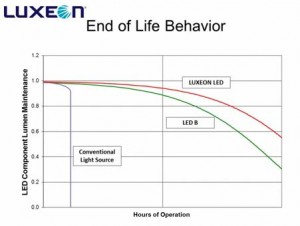Do LEDs Lose Light Intensity with Time?
A special thanks to one of my readers for asking this question. We know that traditional high-intensity discharge lights like high-pressure sodium lights lose their light intensity with time (most lose a significant amount of their intensity in 6-12 months if they are used regularly). This means that if you aren’t careful your plant could suffer from light starvation. The question then is do LED grow lights lose their intensity over time as well?
Simple Answer
Yes LEDs do lose light intensity with time, but not nearly as fast as HID lights. A properly constructed LED light should still be functioning above 70% of original light output for well over 50,000 hours. That’s why the best LED grow light manufacturers offer 3-5 year warranties on their lights.
Detailed Answer
Any time you look at LED lifetime you have to remember there are several factors that determine the actual life of the LED. Those factors include the diode itself, the heatsink, the electrical drivers, the optical design, the mechanical assembly of the grow light, the connections within the grow light, and the amps, volts, and resistance the designer of the diode is trying to run through it. That’s a lot of factors! Any one of these factors could cause the diode to start losing intensity faster than it otherwise would.
For example, many cheap manufacturers of LED grow lights overdrive the diodes (they pump too much electrical juice into them) to make the diode appear very bright. The problem with this is that these diodes will quickly burn out.
Another example is when a grow light manufacturer tries to save money by installing a low-quality heatsink. The diodes will become overheated prematurely and this means they are unlikely to last the 50,000 hours that they are rated at.
As you can see there are a lot of factors that can make your LEDs lose intensity quicker than they should. That’s why I recommend purchasing the best LED grow lights. Yes, they cost more money, but they won’t burn out in a year like some of the cheaper options out there. As I mention on my home page about LED grow lights, as time passes the technology will improve and the prices will continue to drop. At that time, I’ll probably recommend that you buy the cheapest grow light you can find on EBay or Amazon. For now, it’s a good idea to invest in quality.
Here’s a great video from Philips Lumileds that explains what I’m talking about. I especially like the first slide that shows that LED reliability is different than system reliability. It’s worth a quick look.
Lumen Maintenance
Lumen maintenance compares light output at a specified time in the future to its initial output. A good LED grow light should maintain above 70 percent lumen maintenance for over 50,000 hours. To kind of give you an idea of what this percent means the human eye won’t be able to detect any drop off in light output until the light output has depreciated 30 percent. This means you shouldn’t notice a drop in your LED light output for at least 50,000 hours.
Here’s another great video about this from Philips:
PAR Micromole Maintenance
You should know that lumens are a human measurement. A better measurement for plants is the amount photosynthesis active radiation (PAR) they are receiving. PAR is measured in micromoles. You can read more about lumens, PAR, and Micromoles for plants here. I still haven’t found any good research on LED micromole maintenance for plants. I’m currently in discussions with some experts in the field to find out more about this and I’ll keep you posted.



You must be logged in to post a comment.